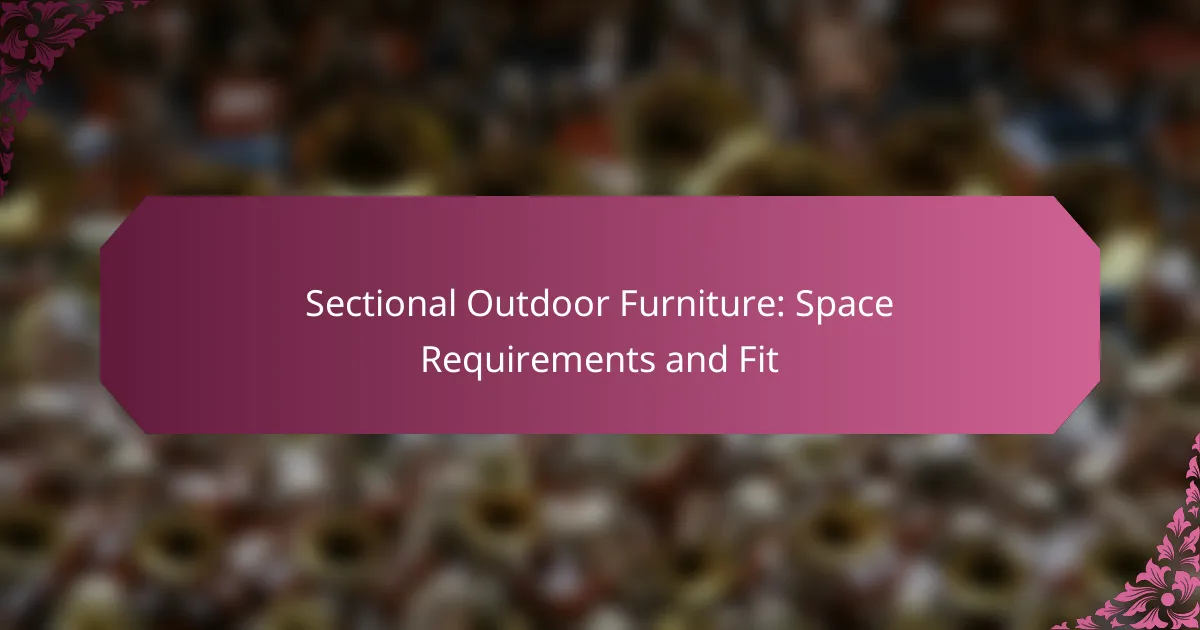When selecting sectional outdoor furniture, it’s essential to consider the space requirements to ensure comfort and functionality. Accurate measurements of your area, along with an understanding of your lifestyle and existing decor, will help you choose a sectional that fits harmoniously within your outdoor environment.

What are the space requirements for sectional outdoor furniture?
Sectional outdoor furniture requires adequate space to ensure comfort and functionality. The space needed will depend on the size of the sectional and the intended layout, including seating arrangements and movement areas.
Minimum space for seating arrangements
To create a comfortable seating arrangement with sectional outdoor furniture, a minimum space of around 10-12 square feet is recommended. This allows for the sectional itself and provides enough room for people to sit without feeling cramped.
Consider the configuration of the sectional; L-shaped or U-shaped designs may require more space to accommodate additional seating comfortably. Ensure that the sectional is positioned to facilitate conversation and relaxation.
Recommended clearance for movement
For easy movement around sectional outdoor furniture, a clearance of at least 2-3 feet is advisable. This space allows individuals to walk around the furniture without obstruction, enhancing accessibility and comfort.
When planning your layout, factor in pathways to and from the sectional, especially if it is near other outdoor features like a grill or dining area. Adequate clearance prevents accidents and promotes a smooth flow of movement.
Impact of sectional size on layout
The size of your sectional significantly influences the overall layout of your outdoor space. Larger sectionals can dominate a small area, making it feel cramped, while smaller sectionals may not provide enough seating for gatherings.
When selecting a sectional, consider the dimensions of your outdoor area and how the sectional will fit within it. A well-proportioned sectional can enhance the aesthetic appeal and functionality of your space.
Common dimensions for sectional sets
Common dimensions for sectional outdoor furniture sets typically range from 6 to 10 feet in length, with depths of 30 to 40 inches. These dimensions can vary based on the design and style of the sectional.
When choosing a sectional, ensure that the dimensions align with your outdoor space’s size and layout. Measure the area to avoid purchasing a piece that is too large or too small.
Examples of popular sectional sizes
Popular sectional sizes include 6-foot L-shaped sectionals, which are ideal for smaller patios, and 8-foot U-shaped sectionals, perfect for larger gatherings. Other options include modular sectionals that can be rearranged to fit various spaces.
Consider your specific needs and the number of people you typically entertain when selecting a sectional size. This will help you choose a piece that not only fits your space but also meets your seating requirements effectively.

How to choose the right fit for your outdoor area?
Choosing the right fit for your outdoor area involves measuring your space accurately and considering how the sectional furniture will complement your lifestyle and existing decor. Prioritize dimensions, style, and flow to ensure a harmonious and functional outdoor environment.
Assessing your outdoor dimensions
Start by measuring the length and width of your outdoor area, taking note of any irregular shapes or features like patios, decks, or gardens. Aim for a clear understanding of the usable space available for furniture placement.
Consider leaving at least 60-90 cm of walking space around the sectional to allow for easy movement. This distance helps prevent overcrowding and ensures comfort for you and your guests.
Evaluating furniture style compatibility
When selecting sectional furniture, consider the overall style of your outdoor area. Whether your space is modern, rustic, or traditional, the furniture should enhance the existing aesthetic.
Choose materials and colors that complement your outdoor decor. For example, a sleek aluminum sectional may suit a contemporary setting, while a wooden option might be better for a more classic look.
Considering outdoor traffic flow
Evaluate how people will move through your outdoor space. Position your sectional to facilitate easy access to other areas, such as pathways, gardens, or entry points.
Avoid placing furniture in high-traffic zones where it may obstruct movement. Instead, create designated seating areas that encourage conversation while maintaining clear pathways.
Matching sectional design with landscaping
Your sectional should harmonize with the landscaping elements in your outdoor area. Consider the colors and textures of plants, stones, and other features when selecting your furniture.
For instance, if you have a lush garden, a sectional with earthy tones can create a cohesive look. Conversely, bright colors can add a pop against a more subdued landscape, enhancing visual interest.

What are the best sectional outdoor furniture options?
The best sectional outdoor furniture options combine comfort, durability, and style to enhance your outdoor living space. Look for modular designs that allow for flexibility in arrangement and materials that withstand various weather conditions.
Top brands for sectional outdoor furniture
Some of the leading brands in sectional outdoor furniture include Sunbrella, Polywood, and Ashley Furniture. These brands are known for their quality craftsmanship and innovative designs that cater to different tastes and budgets.
When choosing a brand, consider customer reviews and warranty options, as these can provide insights into the longevity and performance of the furniture. Brands that offer customizable options may also be beneficial for achieving the perfect fit for your space.
Popular materials for durability
Durable materials for sectional outdoor furniture typically include aluminum, teak, and synthetic wicker. Aluminum is lightweight and resistant to rust, making it ideal for various climates. Teak, known for its natural oils, offers excellent weather resistance and a classic aesthetic.
Synthetic wicker provides a stylish alternative that mimics natural rattan while being more resistant to fading and moisture. When selecting materials, consider the climate in your area to ensure longevity and performance.
Color and style trends for 2023
In 2023, earthy tones like terracotta, olive green, and deep blues are trending for outdoor furniture, creating a connection with nature. These colors can complement various outdoor settings and enhance the overall ambiance.
Additionally, minimalist designs with clean lines and modular configurations are gaining popularity, allowing for versatile arrangements. Incorporating cushions with bold patterns can add a pop of color and personality to your outdoor space.

What factors influence sectional outdoor furniture placement?
Several factors influence the placement of sectional outdoor furniture, including sunlight exposure, proximity to amenities, and wind protection. Understanding these elements can help optimize comfort and functionality in your outdoor space.
Sunlight exposure and shade considerations
Sunlight exposure is crucial when placing sectional outdoor furniture. Consider the sun’s path throughout the day to avoid direct sunlight during peak hours, which can make seating uncomfortable. Positioning furniture near trees, umbrellas, or pergolas can provide much-needed shade.
Evaluate the intensity of sunlight in your area, as regions with high UV exposure may require more shade solutions. Using outdoor fabrics that resist fading can also prolong the life of your furniture.
Proximity to outdoor amenities
Placing sectional outdoor furniture near amenities such as grills, pools, or dining areas enhances convenience and encourages use. Ensure that seating arrangements allow for easy movement between these areas, promoting a cohesive outdoor experience.
Consider the layout of your outdoor space; a well-planned arrangement can facilitate social interactions and make hosting gatherings more enjoyable. Aim for a distance that feels comfortable, typically within a few steps of key features.
Wind protection strategies
Wind can significantly impact the comfort of your outdoor seating. To mitigate its effects, consider placing sectional furniture against walls, fences, or hedges that can act as windbreaks. This positioning can create a more sheltered environment.
Additionally, using outdoor screens or windbreak panels can enhance protection in open areas. When selecting furniture, opt for heavier pieces that are less likely to be moved by strong gusts, ensuring stability and comfort during breezy conditions.

How to measure your outdoor space effectively?
To measure your outdoor space effectively, start by determining the dimensions of the area where you plan to place sectional furniture. This involves measuring the length and width of the space, accounting for any obstacles like trees or pathways that may affect the layout.
Tools for accurate measurement
Using the right tools is essential for precise measurements. A tape measure is the most common tool, typically ranging from 5 to 30 meters, which is suitable for most outdoor spaces. For larger areas, consider using a laser distance measurer, which can provide quick and accurate readings.
Additionally, a notepad or a digital device can help you record measurements as you go. Some smartphone apps also allow you to measure distances using your camera, which can be handy for quick assessments.
Common measurement mistakes to avoid
One common mistake is failing to account for the entire area, including any irregular shapes or features. Always measure the full length and width, and consider drawing a simple sketch to visualize the layout. This helps in planning the arrangement of sectional furniture more effectively.
Another pitfall is not considering clearance space. Ensure you leave enough room for movement around the furniture, typically around 60 to 90 centimeters, to maintain comfort and accessibility. Lastly, double-check your measurements to avoid errors that could lead to purchasing furniture that doesn’t fit your space.

What are the benefits of modular sectional outdoor furniture?
Modular sectional outdoor furniture offers versatility and adaptability, making it an excellent choice for various outdoor spaces. Its design allows for easy rearrangement to fit different layouts and occasions, enhancing both functionality and aesthetics.
Flexibility in arrangement
The primary advantage of modular sectional outdoor furniture is its flexibility in arrangement. Each piece can be moved independently, enabling you to create different seating configurations based on your needs or preferences. This adaptability is particularly useful for entertaining guests or accommodating various activities.
When planning your outdoor space, consider how many sections you might need. A typical modular set may include two to six pieces, allowing for configurations like L-shapes, U-shapes, or even straight lines. This variety ensures that you can maximize your available space while maintaining comfort.
To optimize your layout, measure your outdoor area before purchasing. Leave enough space for movement and consider how the arrangement will work with other elements, such as tables or fire pits. Avoid overcrowding the area to maintain an inviting atmosphere.




